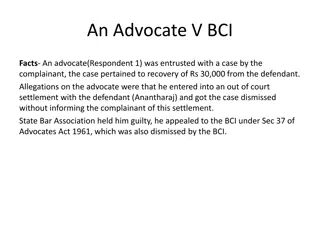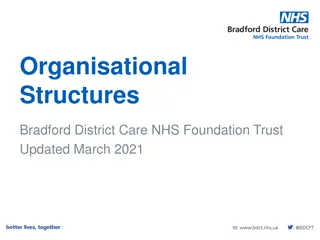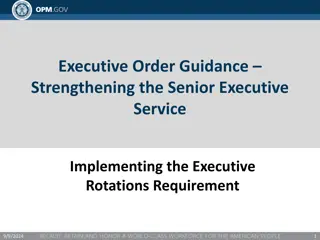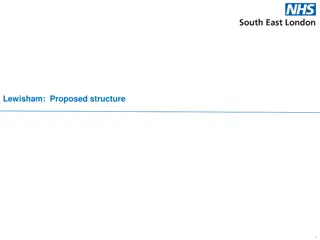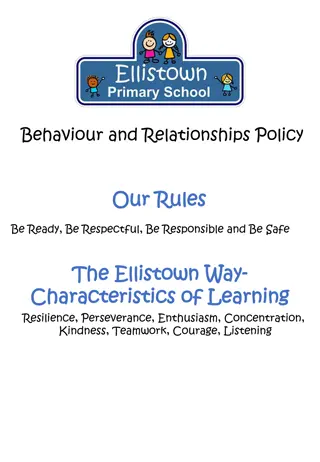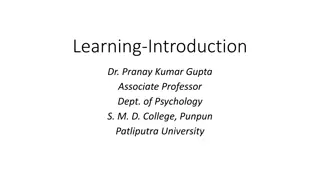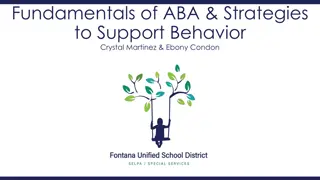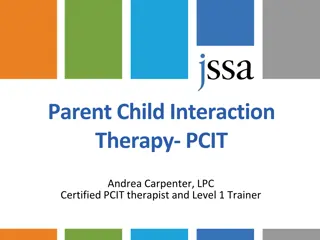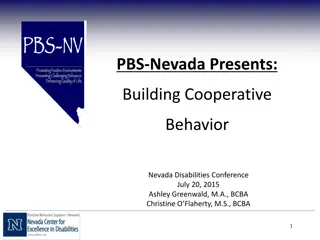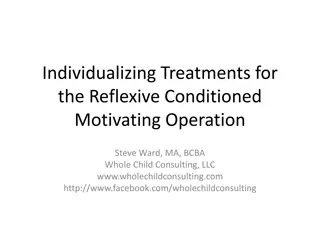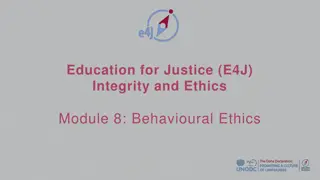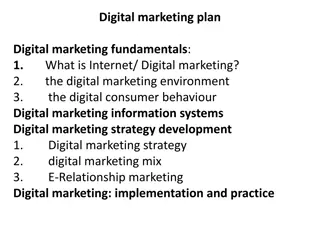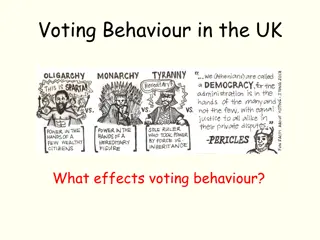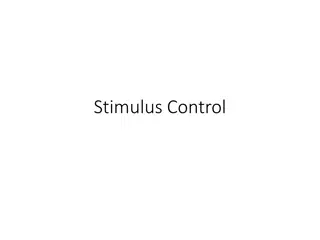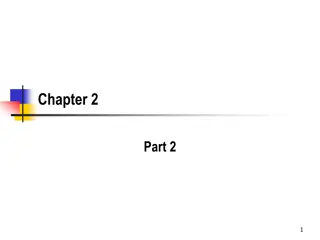Dr. David Bicard - Executive Director and Advocate in Behavior Analysis
Dr. David Bicard is an accomplished professional in behavior analysis, serving as the Executive Director of Great Leaps Learning Center. With over 20 years of experience, he advocates for individuals with disabilities, conducts research, teaches, and holds positions in licensing boards. Additionally, the concept of medical necessity and criteria for determining it in healthcare services are outlined.
Download Presentation

Please find below an Image/Link to download the presentation.
The content on the website is provided AS IS for your information and personal use only. It may not be sold, licensed, or shared on other websites without obtaining consent from the author. Download presentation by click this link. If you encounter any issues during the download, it is possible that the publisher has removed the file from their server.
E N D
Presentation Transcript
Dr. Bicard Biography Dr. David Bicard is the Executive Director of Great Leaps Learning Center where he leads a team of dedicated professionals who implement early intensive behavior analytic therapy. He received behavioral training at the Fred S. Keller School under Janet Twyman and Coursework in Applied Behavior Analysis at Columbia University, Teacher s College (MA, 1998) and The Ohio State University (Ph.D., BCBA, 2001). He has worked in the field for more than 20 years. Since that time and continuing today, Dr. Bicard advocates for people with disabilities and has testified as an expert witness in court cases and at state assemblies. Dr. Biscard has word in group homes, schools, hospitals, and clinics as a technician, researcher, and BCBA. He was an Assistant Professor at Florida International University and The University of Memphis. Dr. Bicard publishes research in behavior analytic and educational peer reviewed journals. He helped establish the initial licensing board for behavior analysts in Kentucky and Alabama. Dr. Bicard teaches as an adjunct professor at the University of Massachusetts-Lowell, Simmons University, and the University of West Florida. He currently serves on the Alabama Behavior Analysis Licensing Board and on the Practice Board of the Association for Behavior Analysis, International. In his free time, he enjoys the company of his wife, children and two dogs.
What does Medical Necessity Mean 59G-1.010 AHCA Definitions Policy August 2017 Medically Necessary or Medical Necessity The medical or allied care, goods, or services furnished or ordered must meet the following conditions: Be necessary to protect life, to prevent significant illness or significant disability, or to alleviate severe pain Be individualized, specific, and consistent with symptoms or confirmed diagnosis of the illness or injury under treatment, and not in excess of the patient's needs Be consistent with generally accepted professional medical standards as determined by the Medicaid program, and not experimental or investigational Be reflective of the level of service that can be safely furnished, and for which no equally effective and more conservative or less costly treatment is available statewide Be furnished in a manner not primarily intended for the convenience of the recipient, the recipient's caretaker, or the provider The fact that a provider has prescribed, recommended, or approved medical or allied care, goods, or services does not, in itself, make such care, goods or services medically necessary or a medical necessity or a covered service.
Determining medical necessity criteria The treatment plan is the vehicle through which medical necessity is determined. Review the plan for its fitness to the severity of the maladaptive behaviors and the intensity of services requested. Missing information or non-specific treatment plans will lead to an administrative or clinical pend. The plan should be no less or no more than what is necessary to convey to the reviewers that the level of care matches the requested services.
Treatment plan components Necessary non-specific information Lead Analyst na1ne and credentials Provider group Referring physician Primary diagnosis Parent and Lead Analyst signatures with dates Please note: "consent to treatment" documents do not meet medical necessity criteria. Reviewers need to know that the parent has read the plan and agreed to the plan of services
Treatment plan components Specific information Background and medical and mental health history Family history Any related services, for example, OT, Speech or any other medical or mental health services (this is a big problem in many treatment plans) Standard instruments used for assessments Operational definitions of maladaptive behaviors that conform to standards of care within the field of applied behavioral analysis Objective, clear, and complete Free of unobservable intentional states (e.g., defiance, refusal, ignoring, etc.) Well defined on-set and off-set Statement of where and when services will take place, typically
Treatment plan components Specific information A description of the functional assessment process including indirect assessment, observation, and/or functional analysis data You do not need to present graphs of indirect assessment data (FAST, MAS, etc.) Data on the maladaptive behaviors including frequency, intensity and duration Hypothesis statement about the functions of the problem behaviors Identification of functional replacement behaviors
Treatment plan components Specific Information Plan for decreasing maladaptive behaviors Targets functional replacement behaviors whenever possible Procedures are tied to functional replacement behaviors and are not a general listing of procedures Any punishment procedures must have a corresponding functional replacement behavior to reinforce Any punishment procedures must have very specific descriptions and MUST include a plan to fade procedures quickly Skills based assessment and outcome data (behavior acceleration targets) Operational definitions of acceleration targets
Treatment plan components Specific Information Short term and long term goals for all behaviors Short term goal- long term goal broken down into smaller steps Long term goal- The identified goal that can be accomplished during the 6 month observation period. Recipient will respond to instructions 30% of the time is not an appropriate short term goal. Recipient will respond independently to 5 different instructions with 90% accuracy over two consecutive days with two different staff is an approp1iate short term goal Statement of justification for the hours requested Must be based on medical necessity only Not on staff or patient availability Must address how the behaviors are interfering with daily functioning and access to typical environment Must be made in relation to the levels of behavioral excess and deficit and the professional judgment of the Lead Analyst on the level of care needed to meet the long term goals The recipient should make measurable gains towards the long term goals each authorization period
Treatment plan components Specific information for continued stay requests H0032 ONLY- Summary statement of progress on treatment with specific information on progress toward long term goals and graphs Graphs that conform to generally accepted standards of care within the field of applied behavior analysis (see Cooper, Heron, & Heward, 2007 for specifics) Narrative summary of progress during the last observation in relation to long term goals for each behavior targeted for treatment. If there is a lack of progress, the provider MUST state what barriers were faced and how the provider intends to modify the current plan to address those barriers
Treatment plan decisions Determining Medical Necessity Assessment Diagnosis The topography of maladaptive behaviors Skill deficits The severity of the maladaptive behaviors relating to accessing typical environments and interfering with daily functioning Treatment Safety of the recipient and others Level of communication deficits of the recipient (his/her type of verbal behavior, including non-verbal) The number of treatment targets Level of independence, including self care The severity of the maladaptive behaviors, including self-stimulatory behavior Fitness of the plan to all of the above
Pitfalls Not describing how the behaviors interfere with the recipients life Not clearly defining target behaviors Not specifying treatment to behaviors Not graphing using standard graphing conventions Not making a plan for changes to treatment when treatment fails or is minimally effective Writing non-specific or boilerplate treatment plans that are not specific to the recipient Listing general procedures (e.g., DRL, DRA, etc.) that are not tied to behaviors or goals Attempting to use non-behavior analytic treatment and get it approved for BA services (e.g., relaxation training, etc.) WE ARE DOING AN ENTIRE WEBINAR ON THIS TOPIC, SO STAY TUNED!





